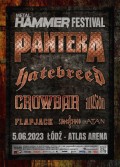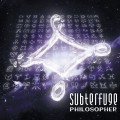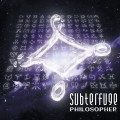
THIN LIZZY - Warszawa
The byproduct of a working class mindset melded with the blues-seeped soul of rock and roll, Thin Lizzy epitomize the guitar-driven sound that earmarked the 1970s, hits "Jailbreak" and "The Boys Are Back In Town" proving critical cogs that make the classic hard rock wheel roll, and the band's tandem guitar attack providing a model that would be emulated by bands the world over.
Penning blue-collar anthems drenched by the pulse of the English pubs and clubs that gave birth to the band, iconic Irish frontman Phil Lynott smartly spawned Lizzy with an international flavor, saddling the Trans-Atlantic guitars of U.K.-born Brian Robertson and American import Scott Gorham with Brit drummer Brian Downey. As critical a component as Lynott's songwriting was, it was only enhanced by the musical schools at play within the band.
"I didn't even think of it back then, but in hindsight I think our cultural differences were unknowingly a very important thing," recalls Gorham, who helms Thin Lizzy's new millennium lineup along with the band's '80s guitarist and current frontman John Sykes, drummer Tommy Aldridge and bassist Francesco DiCosmo. "When I came into the band from Los Angeles in 1974, Brian Robertson had a very traditional British blues style, and I had a very American way of playing, sounding and thinking, and Phil really liked the idea of melding the two styles.
"We were never afraid to experiment and try different things, or to do things in different ways," continues Gorham of Lizzy's seminal roots. "In a lot of cases we knew we would fail, but that didn't stop us from trying. The mantra of the band was that we didn't want to sound like anybody else. We were like the street-punk guys, and while we never caught the art of the studio as well as we'd have liked to, we caught the live art very well. There's no doubt about the fact that our main thing was being onstage and on the road, with the studio a distant second."
Thirty years later, and more than 20 years after Lynott's untimely death, it makes perfect sense that the Thin Lizzy legacy lives on via the band's live performances.
"I have a history of music on my own that I, quite honestly, should probably spend a lot more of my time doing, but I love Scott and Phil, I love being around the music, and I love being a part of this," says Sykes, who broke onto the music scene with New Wave of British Heavy Metal forerunners Tygers of Pan Tang before joining Lizzy in '82, and later found continued fame via Whitesnake, Blue Murder and an acclaimed solo career. "It feels great to be performing these songs. I spent a lot of time with Phil in the studio, so I've seen how he works, watching and observing keenly. I know how the songs are supposed to sound, and I throw my best foot forward."
"We definitely have a more confident edge with what we're doing now," adds Gorham. "We're that much older, wiser players, and more savvy in how we play and better at what we do. Back then it was a brand new thing and we were getting hit left, right and center as it happened, so as players it was hard to improve because we had all this peripheral shit hitting us in the face. Further down the road, we've been able to take a few gulps of air and think about it, relax, and do it better - Well, it's not for me to say it's 'better,' but I feel like we're playing better, because we have the philosophy that we have to bring everything we have to the stage every night. We have to be better than we were in the '70s, because we're missing a chunk - and that chunk is the guy that was in the middle. We have to cover that ground by becoming the better players that we are."
While there's an undeniable adherence to the studio core of every song Thin Lizzy perform, there's an equal adherence to the musicianship and ethos that the band was founded on. "Some people like to hear solos played note-for-note, but those people don't realize that that solo went down on that day because of what you were feeling on that day, or the song was recorded the way it was because we had finite time, and there were different factors that made it what it is. With time, some arrangements change a little, but the core remains the same," says Gorham. "On 'Dancing in the Moonlight,' that wasn't an off-the-cuff solo, I spent time working on that one in the studio, so I play it note for note live. 'Rosalie' is the same thing. On "Still in Love with You," John performs that first solo note-for-note because he felt it deserved that respect, but in my solo at the end, I may do something different every night depending on how I feel.
"The key is, we have pride in not only Thin Lizzy and the band's history, but also in ourselves," Gorham continues. "When you rest on your laurels too much, that's when you fumble the ball, and at that point it stops being fun. As artists, that pride is like a knife's edge and creates a tension in the music that really shines live."
"And, honestly, it's about Phil," sums Sykes. "It's about the music he made, his legacy, and flying that flag. The songs are timeless, Phil's the one that laid them all out there for us to perform and enjoy. Great art transcends time, and it's about honoring and respecting that legacy."
Source: http://www.thinlizzyonline.com/
Current line-up:
John Sykes : Vocals, Guitar
Scott Gorham : Guitar
Tommy Aldridge : Drums
Francesco DiCosmo : Bass
THIN LIZZY
+ support act
27.10.08 - Warszawa, Stodoła, start: 20.00













